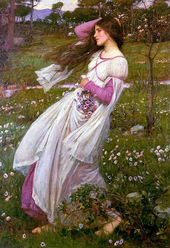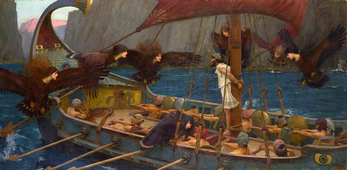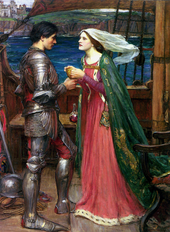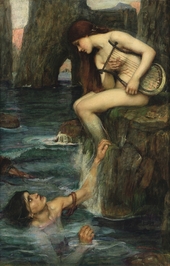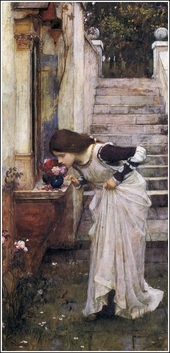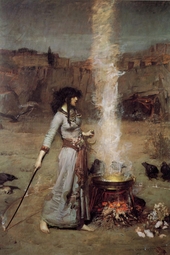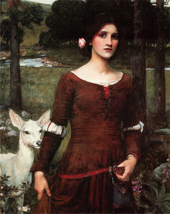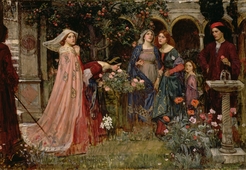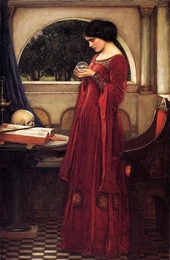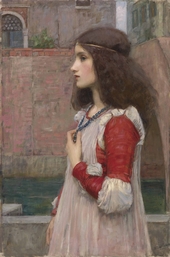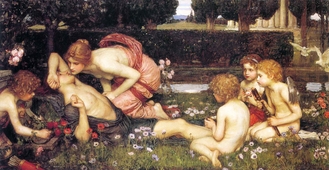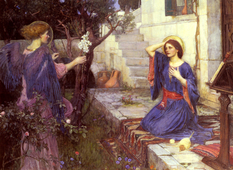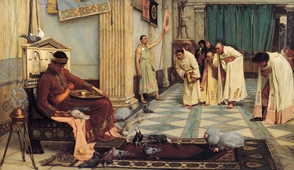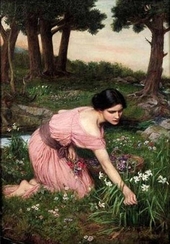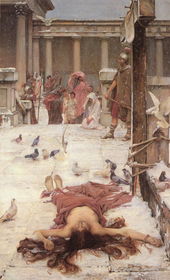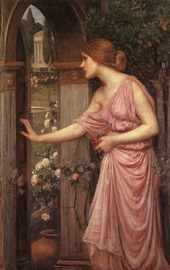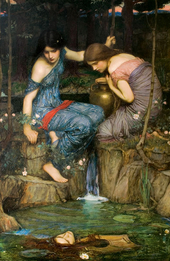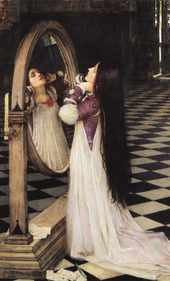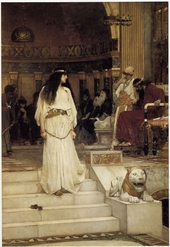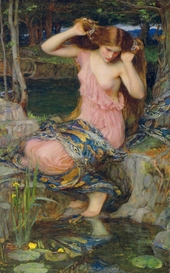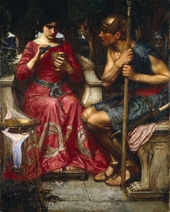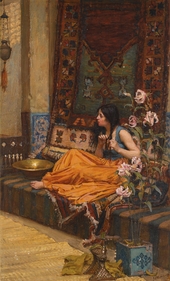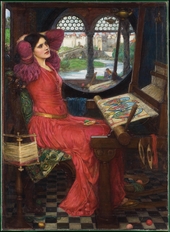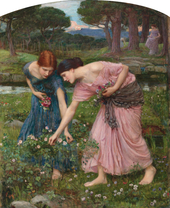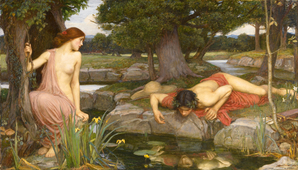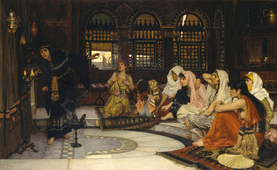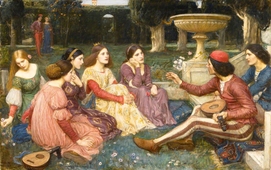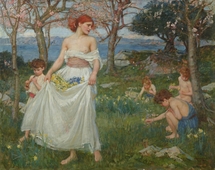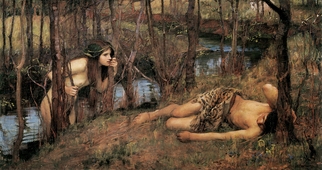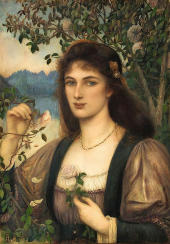Pre Raphaelite Oil Painting Reproductions
Find Pre Raphaelite Oil Painting Replicas By Pre Raphaelite Artists
Pre Raphaelite Art: A Brief Introduction
The Pre Raphaelite Brotherhood was a close-knit group of Victorian artists and academics. Founded in London in 1848, they transformed British art forever. Controversially for the time, the group rejected boundaries between fine arts, literature, and life. Instead, they unceasingly innovated with their artistic approach, constantly experimenting with techniques, composition, and painterly subjects. Discover the answers to common questions about the Pre-Raphaelite Brotherhood and this fascinating movement. Learn about the leading members of the Group and the defining characteristics of their art, and why they were such a revolutionary creative force.
When was the Pre-Raphaelite Brotherhood Active?
The Pre Raphaelites are a loose grouping of artists, illustrators, writers, and poets. This collective lasted from 1848 to the early 1900s. Firmly within the Victorian era, these artists exemplified many concerns of the age. A yearning for a romantic medieval past, concerns over industrialization, and debates over acceptable sensuality were frequently discussed. Indeed, these artists defiantly opposed the capitalist logic and utilitarian philosophy driving British society at the time. In this way, they popularized notions such as art for art’s sake and the value of creative introspection. As a rule, Pre-Raphaelite paintings broadly avoid political commentary, and in contrast to famous authors of the age, they steered away from social campaigning.
Instead, Pre-Raphaelite paintings prioritize careful observation and intricate detail to get closer to the natural world. Perhaps, for this reason, Charles Dickens was no fan of the movement. He once described John Everett Millais’ paintings as the “lowest depths” of everything that is “mean, odious, repulsive and revolting.” Despite this, the Pre-Raphaelite Brotherhood also had influential supporters. Their admirers included famed art critics such as John Ruskin and Walter Pater.
What are the main characteristics of Pre Raphaelite paintings?
A uniquely paradoxical approach to art characterizes pre-Raphaelite art. As an art movement, it revolutionized Modern Art by reviving medieval sensibilities. On the one hand, many artists yearned for a bygone age of medieval knights, chivalric codes, and emotional mystery. In the same breath, however, this nostalgia led to an intense excitement about the future. Many Pre-Raphaelite themes were immensely challenging for the age, dealing with infidelity, sexuality, and religion.
In visual terms, the main characteristics of Pre-Raphaelite paintings were:
- Flattened perspectives and lack of pictorial depth
- Sharp outlines and carefully controlled chiaroscuro
- Bright jewel-toned coloring, particularly of the natural world
- Close attention to detail and hyper-realistic technique
- Flouting classical conventions of symmetrical composition
- Frequent representations of female beauty and religious themes
Why are they called Pre Raphaelites Artists?
The Pre-Raphaelites initially consisted of seven artists who formed a loose association. The name “Pre-Raphaelites” referenced the group’s preference for late-medieval and early Italian Renaissance painting, i.e., originating before the artist Raphael, hence therefore, Pre-Raphaelite. Believing the teaching of the Royal Academy of Arts was far too staid and artificial, the Pre-Raphaelites created a novel approach to painting. Founding members included the painters William Holman Hunt, Dante Gabriel Rossetti, John Everett Millais, Frederic George Stephens, and James Collinson. Joined by the sculptor Thomas Woolner and Rosetti’s brother William Michael Rossetti, they transformed British art.
Pre-Raphaelite inspiration came from painters such as Van Eyck, Hans Memling, and Giotto. The young artists of this art movement prized a return to simplicity and spirituality, an approach amply found in paintings by these Old Masters. Indeed, the still postures and calm atmosphere of Pre-Raphaelite painting owe a great deal to early Italian Renaissance art.
Who was the most famous of the Pre-Raphaelite Artists?
John Everett Millais and Dante Gabriel Rossetti are the most famous Pre-Raphaelites artists. Nonetheless, Ford Madox Brown, Edward Burne-Jones, and John William Waterhouse are extremely popular.
Here’s a brief introduction to five key artists responsible for pioneering the movement.
Ford Madox Brown 1821-1893
Ford Madox Brown often painted moralistic and historical subjects. But, amongst Pre-Raphaelite painters, he was most willing to tackle social and political issues. Indeed, one of Ford Madox Brown’s best-known paintings is Work c1852-1865. A distinctly Hogarthian oil painting, it depicts the entirety of the Victorian social and economic system during the transition to an industrial age. Other Ford Madox Brown paintings reference the traditional Pre-Raphaelite focus on medievalism and literature. However, Maxon Brown also tackled biblical narratives with astounding realism and emotional insight, exemplified in his Religious Art painting Jesus Washing Peter’s Feet. While Madox Brown struggled to gain artistic recognition during the late 1850s and almost emigrated to India. However, this was also his prolific decade, and the artist later gained significant critical acclaim and continued painting until he died in 1893.
Dante Gabriel Rossetti 1828-1882
Rossetti paintings typify Pre-Raphaelite art. As one of the founding members, he also inspired the second generation of Pre-Raphaelite painters, including Edward Burne-Jones and William Morris. Many of his paintings reference medieval revivalism and intense sensuality. For example, Bocca Baciata (Lips That Have Been Kissed) utilizes a Venetian jewel-toned color palette to present its sitter, Fanny Cornforth. For Rossetti, Cornforth represented the platonic ideal of beauty, and the two lived together for many years.
Later paintings by Dante Gabriel Rossetti, for instance, Proserpine 1874, feature another romantic and artistic partner, Jane Morris. Rossetti portrays Morris as the Greek Goddess Proserpina, presenting an exquisitely beautiful woman grasping the fatal forbidden fruit. With rich symbolism and painterly detail, Rossetti’s art stimulated later Symbolist and Aesthetic art movements.
John Everett Millais 1829-1896
As another founding member of the Pre-Raphaelite Brotherhood, John Everett Millais paintings are astounding in their beauty and skill. Millais was a child prodigy, aged 11; he became the youngest student accepted at the prestigious Royal Academy School. Millais drove the group artistically and intellectually with its members meeting at his home at 83 Gower Street, London.
Despite this, by the mid-1850s, Millais moved away from a strict Pre-Raphaelite art style to focus on Realism. The first seeds of this shift are evident in works such as Mariana 1851. Although the medieval setting, dress, and narrative remain, a more naturalistic approach emerges. This change of direction displeased some former champions, such as William Morris. Many felt Millais abandoned the movement’s ideals in place of commercial and popular success.
Edward Coley Burne-Jones 1833-1898
Edward Coley Burne-Jones was loosely associated with Pre-Raphaelite art as a leading designer and artist. He primarily worked alongside William Morris, and the two men championed decorative arts in the UK. Alongside several others, they founded the company Morris, Marshall, Faulkner & Co. In addition to his work with Morris, Burne-Jones rejuvenated the tradition of stained glass in England. He completed many designs throughout his career, with windows in Birmingham, London, Brighton, Frome, and Oxford.
Burne-Jones was also an incredibly accomplished painter. Initially inspired by Rossetti's work, Burne-Jones developed a unique artistic approach. From the late 1860s onwards, he often painted heavily atmospheric works referencing classical mythology. The Wedding of Psyche and The Mirror of Venus are just two examples of his distinctive and mature oil paintings.
John William Waterhouse 1849-1917
Last but not least, in this introduction to famous Pre-Raphaelite painters is John William Waterhouse. While younger than many founding members, Waterhouse embraced the Brotherhood’s artistic approach. Whereas Waterhouse began his artistic career working in a traditional academic style, he quickly adopted Pre-Raphaelite techniques and subject matter. The group's fascination with Shakespearean subjects appears in oil paintings such as Ophelia 1894 and mythological paintings like Mermaid 1900.
John William Waterhouse paintings also reference ancient Greek literature and the works of Homer, in addition to modern Romantic poets such as Keats and Tennyson. As a reflection of the artist's integral importance to British art and the later Pre-Raphaelites, Waterhouse paintings remain displayed in prominent galleries such as London’s Royal Academy and Tate Britain.
What is the most famous painting of Pre Raphaelite Art?
John Everett Millais painting Ophelia is the artist’s greatest masterpiece and the Pre-Raphaelite Brotherhood’s most iconic painting. It is also cataloged as one of our most Famous Paintings. Inspired by Shakespeare’s Hamlet, the playwright was on the Pre-Raphaelite’s list of “Immortals” as painters, academics, and writers they particularly admired. The painting depicts Ophelia, the tragic character who drowned in a river. In the play, Queen Gertrude reports that Ophelia climbed into a willow tree and that when the branch broke, Ophelia fell into the brook below and drowned.
Like many John Everett Millais paintings, his attention to detail and professional presentation of the natural world is astounding. The willow leaves, branches and various identifiable wildflowers float alongside Ophelia’s dying body. When first exhibited at the Royal Academy, the painting received a mixed critical reaction. One critic described it as “strangely perverse,” and another likened Ophelia to a “dairymaid in a frolic.” Nonetheless, the painting has become one of the most famous and admired examples of Pre-Raphaelite art.
Pre Raphaelite Art Reproductions
Buy Pre Raphaelite brotherhood replica art. Enjoy and explore our unparalleled collection of oil paintings.
Reproduction paintings on canvas include famous Pre Raphaelites artworks by artists John Everett Millais, Dante Gabriel Rossetti, and John William Waterhouse.
Cannot Find What You Are Looking For?
Reproduction Gallery Information
Customer Service
(Send Us A Message)
Tel: (503) 937 2010
Fax: (503) 937 2011

